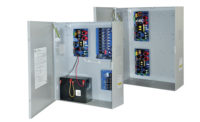Fire systems are mandatory in all commercial buildings as well as residential units. Most fire alarm panels are limited to the amount of power they can deliver, so supplemental power supplies are often needed to power notification appliances circuits (NAC). Installers who are not very familiar with fire systems may think that any power supply with enough current and the right voltage settings can fulfill the need for supplementary power, but that’s not always the case.
Synchronization protocols established by fire system product manufacturers are one of the main features supplementary NAC power extenders must provide. These protocols ensure that emergency strobe lights are all synchronized and flash simultaneously. This is critical, as individuals with epilepsy could suffer from seizures if the strobes are out of sync.
NAC power extenders also offer different types of outputs to accommodate various devices. With fire systems, installers must take into account how the loop for the circuit will be wired using either Class A or Class B wiring methods. Class A uses 4 terminals on the power supply while Class B uses 2 terminals. When looking for a NAC power extender, units labeled as 4 Class B outputs or 2 Class A outputs are typical. However, newer NAC power extenders have been known to have up to 8 Class B circuits or 4 Class A circuits. With Class A, a complete loop is established with the 4 wires using 4 terminals. If a NAC on the circuit were to fail, all the other NACs would still continue to work. A trouble condition would still be alerted in this situation, but minimal components of the system would be affected. Class B uses an end of line resistor to monitor any troubles on the 2-wire circuit using 2 terminals. If a failure should happen in a Class B circuit, the notification appliances that are in line beyond the failure point would be affected as well. It is extremely important that the resistor be installed at the last notification appliance on the loop to notify of any trouble condition that would precede it.
In addition to selecting a NAC power extender with sufficient available total current, it must also offer enough available current for each circuit. These are perhaps the two most important features to look for when evaluating a NAC power extender. Just recently, some manufacturers have added intelligent features to their NAC power extenders, which enable them to be networked. Although NAC power extenders are required to be programmed locally, they can be monitored remotely without the need for a service truck-roll. This greatly increases response time to system issues while minimizing personnel time and related expenses. Embedded trouble memory logs also help service technicians diagnose issues faster when dealing with intermittent problems by providing the historical information they need to help identify and correct issues.
New NAC Power Extender features include:
• programmable resistor values, which are extremely useful when doing a takeover;
• CD panels on the front door to quickly visually identify problems on specific circuits;
• the ability to program outputs as Auxiliary to accommodate additional devices such as door holders or duct detectors; and
• temporal Code 4 for carbon monoxide detection, which is moving towards becoming a requirement for fire systems.
While codes change and fire alarm panel manufacturers continue to adapt to changing requirements and industry needs, the importance of selecting NAC power extenders with the right feature sets is critical. Over the years NAC power extenders have proven to accommodate a wide range of devices and requirements — now they’ve evolving further to manage fire systems with greater overall efficiency. — By Ronnie Pendleton, National Accounts Manager, Altronix.









